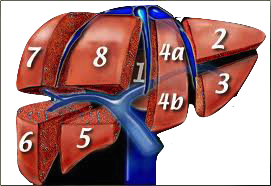TAE
Transarterial Catheter Embolization
The liver is divided into 8 segments. Dr. Ubara embolizes the hepatic artery supplying the dominant liver segments that has been replaced by cysts. See the picture below of the blood vessels that supply the liver. Transarterial catheter embolization (TAE) can be an effective curative procedure. After a follow-up of two years, a decrease in liver volume of 54% was seen. Patients with polycystic liver often suffer from abdominal discomfort, dyspepsia, or dyspnea; however, there have been few ways to relieve their symptoms effectively and safely. Dr. Ubara does transcatheter arterial embolization (TAE) embolizing the hepatic arteries supplying the dominant cystic segments by using polyvinyl alcohol particles and micro-coils. This is done by an interventional radiologist under imaging. Individuals have pain for about 3 days. This is controlled with pain medication. The Mayo clinic stopped performing this procedure as their patients experienced too much pain. Adequate pain control was a problem. The embolized areas slough off and re-absorb within about a year. By the end of two years there has been 54% reduction noted in cystic liver size. There are mixed feelings about this procedure. Four individuals have written that they gotten it done, some even traveling to Dr. Ubara. Only one individual was happy with the procedure. The other three were not.
Not a candidate for a liver resection, a fellow PLD'r is willing to look into trying this TAE procedure.
